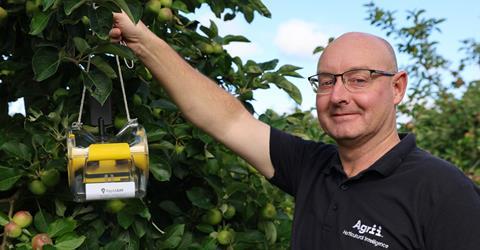The tech aims to improve crop protection by enabling more targeted use of insecticides to combat moths

RapidAim will soon be enabling UK farmers to monitor codling moth numbers remotely and in real-time with the launch of a new pheromone-based detection system.
It aims to improve crop protection by enabling more targeted use of insecticides to combat moths.
The system will be rolled out nationally in 2025, following a formal launch to growers this autumn.
Developed in Australia, the technology is being brought to the UK by chemical company UPL but will be available exclusively through Agrii - following its assessment in orchards across Kent and East Sussex over the last year.
RapidAim differs from the pheromone-traps growers are likely to be more familiar with as it is not a trap, but a monitoring station arranged as a connected network. Data on moth numbers is collected as the insect passes through the device.
In 2023, the first year of trials, RapidAim units were situated in orchards across Kent, with the trial expanded to include Sussex earlier this year. There are now more than 60 units in place with some of the leading commercial growers in the region.
Agrii fruit agronomist, Brendan Rhodes said: “We have spent the past two seasons assessing and validating its capabilities with a network of growers across Kent and Sussex.
“Those users who trialled it reported that the data presented was consistent with the pest numbers they were seeing in orchards and, perhaps reassuringly, more accurate than indicated by pheromone traps.”
Rhodes added: “The results have been highly encouraging. It quickly gained the trust of the growers involved who recognised the value of real-time data in supporting crop protection strategies.”
Agrii technical manager for non-combinable crops, Don Pendergrast says that RapidAim offers a more accurate and reliable form of monitoring moth populations.
He commented: “Unlike other systems, RapidAim does not rely on images captured on a semi-regular basis during the day.”
“Nor does it require data-hungry services such as the 4G mobile phone network.”
Pendergast explained that instead, it uses an “algorithm to identify the pest being monitored” before relaying the information via the narrow-band mobile network.
“This supports excellent connectivity and means RapidAim does not suffer the connectivity issues often experienced in rural areas.”



